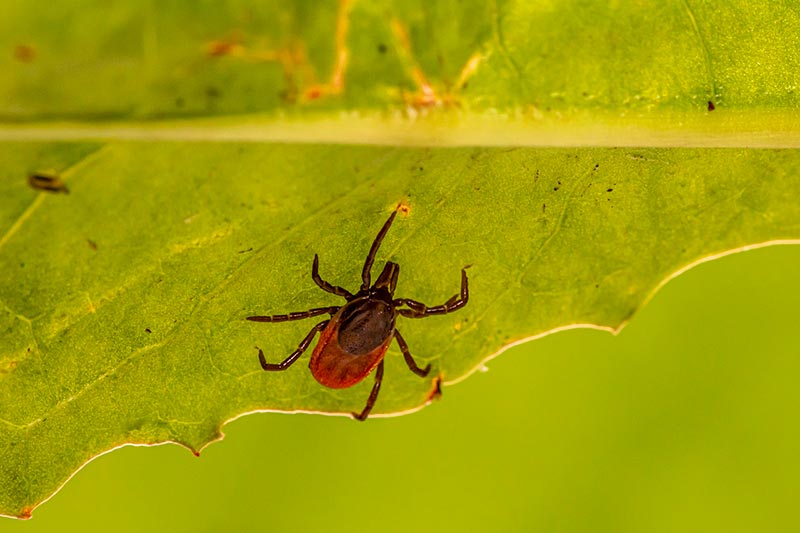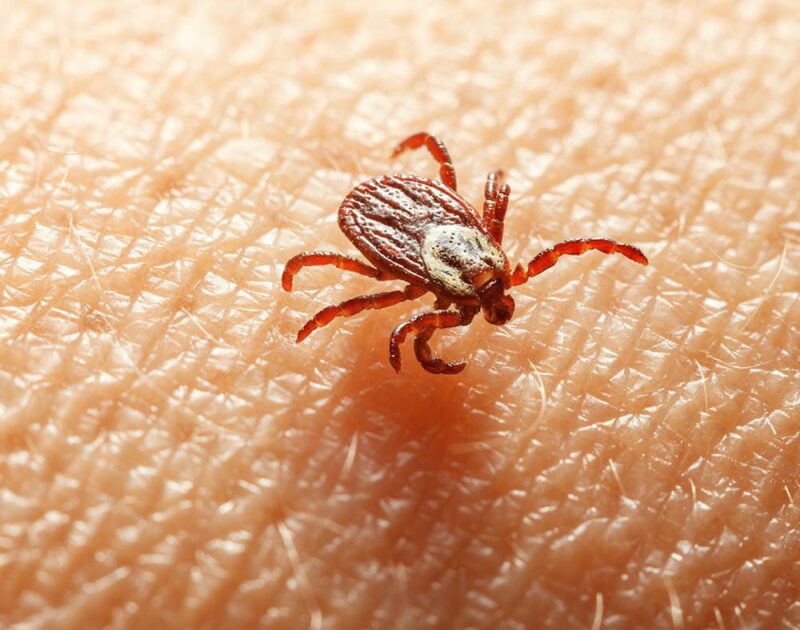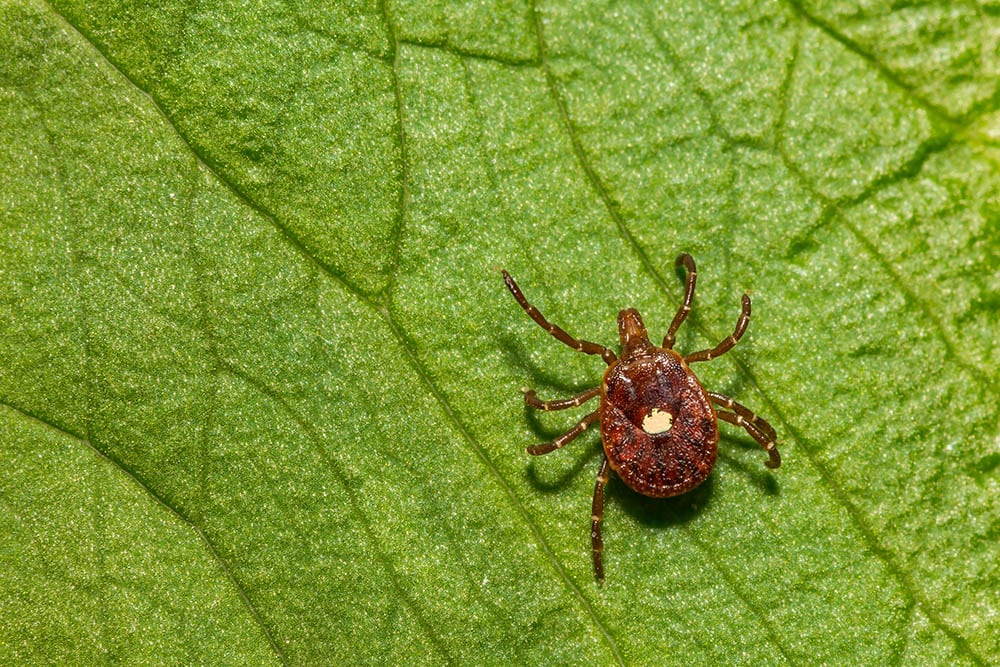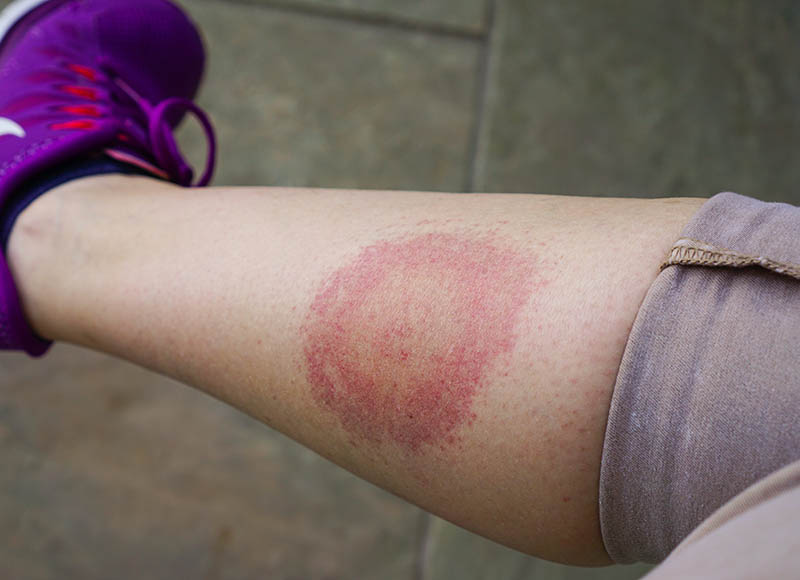4 Types of Ticks in New York (With Pictures)
-
Pete Ortiz
- Last updated:

The Big Apple is famous for its towering skyscrapers and Broadway plays, but it is also an excellent place for outdoor activities such as trail running and mountain biking in some of New York’s gorgeous parks. We love soaking up the sun and getting into nature, but even though nature gives us so much beauty, she also has some not-so-friendly residents who enjoy the outdoors.
Ticks are a common pest in New York that thrive in balmy summers. If you enjoy spending time outdoors, especially away from the city, you need to be aware and knowledgeable about ticks, how you can prevent them, and what to do if they latch on.
The 4 Types of Ticks in New York
1. Black-Legged Ticks

| Lifespan: | 2–3 years |
| Color: | Brown, reddish brown |
The black-legged tick, also known as the deer tick, has three life stages, each with its own distinct appearance. They will also look different depending on whether they have had a meal. When black-legged ticks are small, they are flat, oval-shaped, dark reddish brown with eight legs. Their size is similar to the small size of a sesame seed. The babies, or nymphs, look similar to the adults but are as small as a poppy seed. When a black-legged tick is engorged, meaning it has recently had a meal, its abdomen is swollen and round and will appear a darker shade of red.
They will only feed on their host’s blood. Their chosen host is a mammal such as a deer, but it will depend on the stage of their life cycle. The adults are usually found on bigger mammals, while the nymphs will feed on smaller mammals such as birds and mice.
Their range is widespread but usually depends on the humidity, elevation, and host availability levels. They can be abundant in grassy areas with lots of fallen leaves and forested regions.
They are most active from March through to October, which may seem like a long time, but June and July carry the highest risk for infection.
2. American Dog Ticks

| Lifespan: | 2 years |
| Color: | Brown or gray with white spots |
The American dog tick, also known as the wood tick, is a hard tick, meaning it has a hard exterior shield. They are flat and oval-shaped and brown with pale gray markings.
Because American dog ticks are drawn to the scent of animals, they are common along roads and trails. They also prefer grassy, low-vegetation areas where larger mammals pass by. It is common for American Dog Ticks to use humans as their host, usually on the crown of the head.
The males will feed for about 2 days without becoming engorged, after which they will detach and search the host for a female to mate with. Females can take up to a week to fully engorge and then detach from their host and drop into the leaf litter, where they can lay over 4,000 eggs before dying. Adult males and females are active in most areas from April to early August.
American dog ticks are known to carry bacteria that cause diseases in humans, such as Rocky Mountain spotted fever, which they spread by sucking blood from their hosts. Antibiotics can treat the disease, which can be fatal if left untreated. Tularemia is another disease that the ticks transmit; symptoms include fever, chills, and tender lymph nodes. An ulcer may form at the site of the tick bite. Tick paralysis, caused by American dog ticks, can result in severe respiratory distress and muscle weakness in those affected.
3. Lone Star Ticks

| Lifespan: | 2 years |
| Color: | Brown, females have a white spot on their backs |
Male lone star ticks have spots or streaks of white pigment around the outer edge of the body, while females have a single white dot in the center of a brown body. Lone star ticks are most commonly found in densely forested woodlands and near animal resting areas. They feed on the blood of both domesticated and wild animals, as well as humans, but they may be brought into the home on pets.
The adults are active from April to late August and can be found on tall, shaded grass. Nymph stages typically travel at a lower altitude and latch onto hosts from the shoe to the shin, but they move so quickly that by the time you notice them, they’re waist high. The bite of a lone star tick is associated with the development of a red meat (alpha-gal) allergy in some people.
4. Asian Longhorned Ticks

| Lifespan: | 2 years |
| Color: | Reddish yellow |
The Asian longhorned tick is invasive and can be found in grass, shrubs, or on animals. Because female ticks can lay eggs and reproduce without mating, only one tick is required to establish a population in a new location. The Asian longhorned tick is a three-host tick, which means that after taking a blood meal, each active stage will leave the host to digest the blood meal before developing and molting into the next stage.
It has a 6-month life cycle, but only one generation occurs per year, with most immature ticks going dormant during the winter and other cold seasons. The Asian longhorned tick is less attracted to human skin than well-known native ticks, but it does have the ability to increase tick-borne pathogens by spreading it to other common ticks.
Tick Related Diseases
If a tick has chosen you as its host, there is no need to panic. Tick bites are most often harmless. However, some can cause allergies and potentially dangerous diseases if they are not treated. Some people may be allergic to tick bites, and if bitten, symptoms can include pain and swelling, rash, burning, and shortness of breath.
Ticks can transmit potentially fatal diseases to humans. Most tick-borne disease symptoms will appear within a few days to a few weeks of a tick bite. Common tick-borne diseases include Lyme Disease, tularemia, Rocky Mountain spotted fever, Colorado tick fever, and ehrlichiosis.
Lyme Disease
Lyme disease is one of the most common tick-borne diseases in America. It is transmitted to humans through the bite of a black-legged tick.
When bitten by a tick, sometimes a small red bump appears and will disappear after a few days. This bump is common and means that you have contracted Lyme disease. After a few months of being bitten, symptoms of Lyme Disease may include fatigue, fever, chills, headache, a bull’s eye rash, and swollen lymph nodes.
Over a few days, the rash expands and spreads and may feel warm to the touch. It can also develop in more than one place on the body. Symptoms that appear later on include bouts of joint pain and swelling, erythema migraines, and some neurological issues that may even present after years. These neurological issues can appear as impaired muscle movement, Bell’s palsy, numbness of limbs, and meningitis.

Alpha-Gal Allergy
Alpha-Gal allergy is a condition only recently surfaced, caused by the bite of a lone star tick. The tick’s bite transmits a sugar molecule known as alpha-gal into the body, which triggers an immune reaction that develops an allergy to red meat and other mammal products.
Researchers now believe that alpha-gal syndrome affects some people who have frequent, unexplained anaphylactic reactions despite testing negative for other food allergies. The only way to prevent a reaction is to avoid red meat.
Symptoms of Alpha Gal usually only appear 3–6 hours after being bitten. They may include itching or hives, shortness of breath, diarrhea, nausea, headaches and swelling
FAQ
When Is Tick Season in New York and How Can I Prevent Tick Bites?
Ticks are most active in New York during the spring and summer but can be active at any temperature above freezing.
- When outdoors, wear long sleeved shirts, closed shoes, and long pants.
- Wear light colors to help you identify ticks sooner.
- Keep long hair tied back.
- When hiking or walking in wooded areas, avoid vegetation and stay in the center of trails.
- Use an insect repellent containing at least 20% DEET.
- Frequently check yourself and your pets during your walk and check again thoroughly when you return home.
What to Do If You Are Bitten by a Tick
If you discover a tick has latched onto your skin, don’t panic!
- Pull back the hair or fur to expose the tick.
- Using tweezers, grasp the tick by the head, close to the skin, and try your best to NOT squeeze its body.
- Pull the tick out quickly and firmly, but do not twist it or wiggle it.
- Dispose of the tick with rubbing alcohol or flush it down the toilet.
- Clean the bite area with soap and water.
- For the next 30 days, keep an eye on the bite site for a developing rash. If you develop a rash or flu-like symptoms, contact your doctor right away.
Conclusion
Ticks are nasty parasites that can cause some serious health issues, and New York is home to a few of them. Tick bites don’t always mean that you will get sick, but it is vital to check yourself and your pets thoroughly, especially after being outdoors. Ticks shouldn’t stop you from enjoying the outdoors, but prevention is better than seeking treatment and wearing long pants and closed shoes can help deter a tick from latching on.
- Related Read: 4 Types of Ticks in Massachusetts (With Pictures)
- pestworld.org
- health.ny.gov
- assuredenvironments.com
- tickcontrol.com
- https://www.cdc.gov/lyme/index.html#:~:text=Lyme%20disease%20is%20caused%20by,skin%20rash%20called%20erythema%20migrans.
- https://www.healthline.com/health/tick-bites#symptoms
- https://www.mayoclinic.org/diseases-conditions/lyme-disease/symptoms-causes/syc-20374651
- https://www.mayoclinic.org/diseases-conditions/alpha-gal-syndrome/symptoms-causes/syc-20428608#:~:text=Alpha%2Dgal%20syndrome%20is%20a,gal%20into%20the%20person’s%20body.
Featured Image Credit: Napat, Shutterstock
Contents



